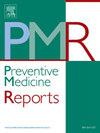Characterizing hypertension among recreational cyclists in Colombia: The Atlántico cyclists study
IF 2.4
3区 医学
Q2 PUBLIC, ENVIRONMENTAL & OCCUPATIONAL HEALTH
引用次数: 0
Abstract
Objective
To describe the prevalence of hypertension and exercise-induced hypertension (EIH) among recreational cyclists in addition to their exercise habits and prior medical evaluations.
Methods
A cross-sectional study was conducted among adult recreational cyclists from March to April 2024 in the Department of Atlántico, Colombia. Participants were selected via convenience sampling after cycling activities and data were collected with a structured survey (demographics, comorbidities, and exercise habits). Post-exercise blood pressure (BP; two measurements three minutes apart), heart rate, oxygen saturation, weight, height, and waist circumference were measured. EIH was defined as a systolic BP > 210 mmHg for men and > 190 mmHg for women. Data were summarized with descriptive statistics.
Results
Three hundred and fifty-five individuals were included. Most were male (84.5 %) and older than 45 years of age (75.8 %). Hypertension was identified in 22 % of participants. Other risk factors included hypercholesterolemia (11.8 %), smoking (10.4 %), and hypertriglyceridemia (7.3 %). The mean post-exercise systolic BPs were 130.4 ± 55.6 mmHg and 122.6 ± 15.5 mmHg, and diastolic BPs were 77.2 ± 10.4 mmHg and 76.8 ± 10.7 mmHg (initial and three minutes later, respectively) and no participants fulfilled the criteria for EIH. Among the participants, 20.6 % underwent prior medical evaluation.
Conclusions
Hypertension was a common baseline condition among recreational cyclists, but none was found to have EIH. Despite a high prevalence of cardiovascular risk factors, one-fifth of the participants had a medical evaluation before engaging in cycling activities. Our findings underscore the importance of encouraging routine health screenings in this population.
哥伦比亚休闲骑行者的高血压特征:Atlántico骑行者研究
目的了解休闲骑自行车者的高血压和运动性高血压(EIH)患病率、运动习惯和既往医学评价。方法对2024年3 - 4月在哥伦比亚Atlántico省开展的成人休闲自行车骑行者进行横断面研究。参与者在骑车活动后通过方便抽样选择,数据通过结构化调查(人口统计、合并症和运动习惯)收集。运动后血压(BP;两次测量(间隔三分钟)、心率、血氧饱和度、体重、身高和腰围。EIH的定义是:收缩期血压升高;210毫米汞柱男性和>;女性190毫米汞柱。数据用描述性统计进行汇总。结果共纳入355名个体。多数为男性(84.5%),年龄大于45岁(75.8%)。22%的参与者有高血压。其他危险因素包括高胆固醇血症(11.8%)、吸烟(10.4%)和高甘油三酯血症(7.3%)。运动后平均收缩压分别为130.4±55.6 mmHg和122.6±15.5 mmHg,舒张压分别为77.2±10.4 mmHg和76.8±10.7 mmHg(初始和三分钟后),没有参与者符合EIH的标准。在参与者中,20.6%的人接受了事先的医疗评估。结论高血压是休闲骑行者常见的基线状况,但未发现有EIH。尽管心血管危险因素的患病率很高,但五分之一的参与者在参加自行车活动之前进行了医疗评估。我们的发现强调了在这一人群中鼓励常规健康筛查的重要性。
本文章由计算机程序翻译,如有差异,请以英文原文为准。
求助全文
约1分钟内获得全文
求助全文
来源期刊

Preventive Medicine Reports
Medicine-Public Health, Environmental and Occupational Health
CiteScore
3.90
自引率
0.00%
发文量
353
 求助内容:
求助内容: 应助结果提醒方式:
应助结果提醒方式:


